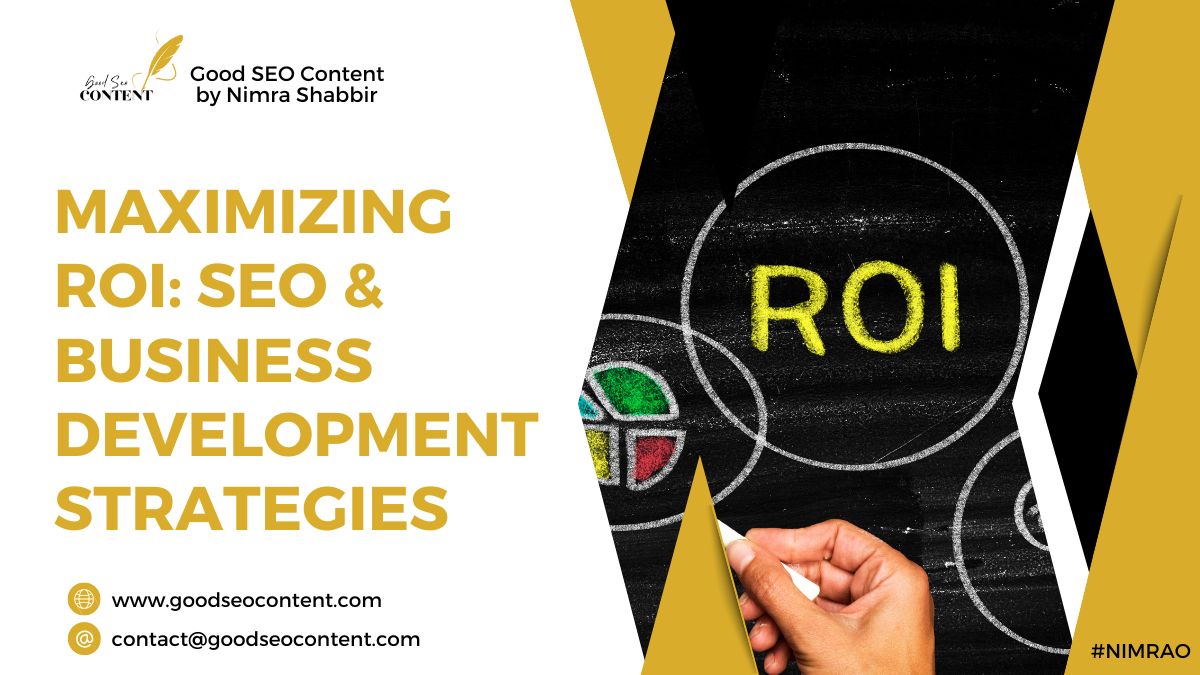Aligning your SEO and business development strategies is crucial for maximizing ROI. By integrating these two elements, you can drive traffic while ensuring that these efforts contribute to the overall growth and profitability of your business. In this guide, we’ll explore how to effectively align SEO with business development, providing practical strategies to help you maximize your ROI.
Table of Contents
1. Understanding the Connection Between SEO and Business Development
SEO (Search Engine Optimization) is about optimizing your website to improve its visibility on search engines, driving organic traffic. Business development, however, focuses on identifying opportunities for growth, forming strategic partnerships, and expanding the business. When these two areas are aligned, they work together to achieve common business goals, such as entering new markets or increasing revenue.
Read: The Art Story Telling in business Development

2. Steps to Align SEO with Business Development
A. Define Business Goals Clearly
Start by clearly defining your business goals. Whether you’re aiming to increase market share, expand into new markets, or boost revenue, your SEO strategy should align with these goals. For example, if you’re targeting a new market, your SEO should focus on optimizing for local search terms and creating content tailored to that audience.
B. Perform Comprehensive Keyword Research
Keyword research is essential for aligning SEO with business development. Instead of just focusing on basic keywords, delve deeper into terms that align with your business development goals. For instance, if you’re targeting large enterprises, focus on keywords like “enterprise SEO solutions” or “corporate SEO strategies” to attract the right audience.

Read: Content Leads generation in business development
C. Optimize Content to Support Business Goals
After identifying the right keywords, create and optimize content that supports your business development goals. This could include blog posts, case studies, and white papers that address the pain points of your target audience. Ensure that your content not only ranks well in search engines but also establishes your business as a thought leader in the industry.
D. Use SEO Data to Inform Business Decisions
SEO data offers valuable insights that can inform your business development strategy. For example, analyzing which keywords drive the most traffic can help identify potential growth areas. Additionally, understanding which pages convert the best can guide your business development efforts towards the most profitable areas.
3. Integrating SEO with Other Marketing Channels

Read: Boosting Online Visibility with SEO
A. Coordinating SEO with Paid Search
Combining SEO with paid search strategies, like Pay-Per-Click (PPC) advertising, can greatly enhance your ROI. By using insights from your SEO efforts, you can allocate your PPC budget more effectively, targeting high-performing keywords and audiences. This ensures that both your organic and paid strategies are aligned and working towards the same business objectives.
B. Working Closely with Sales Teams
Your sales team can provide critical insights into the needs and challenges of your target audience. Collaborating with them allows you to create SEO content that addresses these needs, increasing the likelihood of converting visitors into leads and customers. This collaboration ensures that your SEO efforts are not just driving traffic but also generating tangible business results.
4. Measuring and Optimizing ROI

Read: SEO for Brand Awareness
A. Monitoring Key Metrics
To gauge the success of your aligned SEO and business development strategies, track key metrics such as organic traffic, conversion rates, and revenue generated from organic search. Tools like Google Analytics can help you monitor these metrics and identify areas where you can improve.
B. Regularly Re-optimizing Content
SEO is an ongoing process. To continuously maximize ROI, regularly re-optimize your content based on performance data. This might involve updating old content, adding new keywords, or improving the user experience on your website. Regularly reviewing and updating your SEO strategy ensures it stays aligned with your business development goals.
5. Overcoming Common Challenges

Read: SEO Strategies
A. Balancing Short-Term and Long-Term Goals
One of the main challenges in aligning SEO with business development is balancing short-term and long-term goals. While business development often seeks quick wins, SEO is a long-term strategy. To overcome this challenge, set clear expectations and timelines for both short-term and long-term goals, ensuring that your SEO strategy can adapt as your business needs evolve.
B. Facilitating Cross-Department Collaboration
Successful alignment requires collaboration across various departments, including marketing, sales, and business development. Establish regular communication channels and shared goals to ensure everyone is working towards the same objectives.

In order to get professional SEO and Business Development consultation advices contact NimRao at contact@goodseocontent.com or you can catch me up at instagram (@nimra_shabbir01), Linkedin (Nimra Shabbir). I would like to consult about your SEO needs so make sure to leave a message!
Conclusion
Aligning SEO with business development is not just a strategic move; it’s essential for maximizing ROI and ensuring long-term business growth. By clearly defining your business goals, performing comprehensive keyword research, and creating content that directly supports your objectives, you can ensure that your SEO efforts are driving meaningful results. Additionally, integrating SEO with other marketing channels and regularly measuring and optimizing your strategies will keep your efforts aligned with your business development goals.
Remember, the key to success lies in continuous improvement. Regularly revisit and refine your strategies to stay ahead of the competition and adapt to the ever-changing digital landscape. When SEO and business development work in harmony, the potential for growth and profitability is significantly enhanced, making your business more resilient and successful in the long run.
It ensures that your SEO efforts directly contribute to achieving your business goals, such as increasing revenue or entering new markets, leading to a higher return on investment.
Keyword research helps identify terms that align with your business development goals, ensuring that your SEO strategy targets the right audience and supports your overall business objectives.
By creating content that addresses the specific needs of your target audience, you can position your business as a thought leader, attract the right audience, and drive conversions.
Key metrics to track include organic traffic, conversion rates, keyword rankings, and revenue generated from organic search. Tools like Google Analytics can help you monitor these metrics.
Yes, integrating paid search with SEO can enhance your digital marketing strategy by ensuring both channels are targeting high-performing keywords and audiences, leading to a more cohesive approach.
Re-optimization should be an ongoing process, with content being reviewed and updated regularly to ensure it remains relevant and aligned with your business goals.


2 thoughts on “Maximizing ROI in 2024 : Align Your SEO and Business Development Strategies”